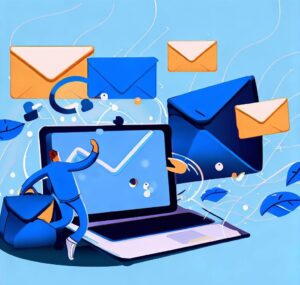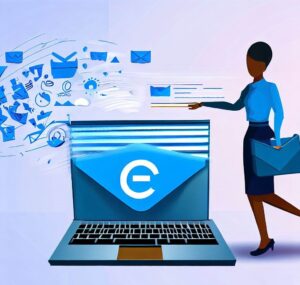Gmail Logger is a powerful email tracking and monitoring tool that provides valuable insights into your email performance. With this Google Sheets add-on, you be able to easily track when ever your emails are opened any where, when your email is clicked, and replied to. This information allows you to understand the engagement of your recipients and make data-driven decisions to improve your communication skills.
Using Gmail Logger can help you monitor your email communication with clients, customers, and other contacts. This feature is particularly useful in sales and marketing scenarios, where timely and personalized communication is crucial. Tracking the engagement of your recipients helps you gauge their level of interest and tailor your follow-up accordingly.
Installing Gmail Logger is a simple process. Head over to the Google Workspace Marketplace and find the add-on. Once you have successfully installed the add-on you will have access to a range of features that can enhance your email analytics. From tracking individual emails to generating comprehensive reports, Gmail Logger empowers you to make informed decisions and optimize your email communication strategy.
What is Gmail Logger
Gmail Logger is a powerful tool that provides email tracking and monitoring capabilities. With this Google Sheets add-on, you can easily keep track of your email activity, in order to understand how its performing. This valuable information allows you to better gain more insights into the performance of your email and make data-driven decisions to improve your communication skills.
One of the key benefits of Gmail Logger is its ability to help you monitor your email communication with clients, customers, and other contacts. Through tracking the engagement of your recipients, you can gauge their level of interest and tailor your follow-up accordingly. Particularly this can be very useful in sales and marketing scenarios, where timely and personalized communication is crucial.
How to use Gmail Logger to track your email activity

To begin using Gmail logger to track your email activities, make sure you have installed Gmail Logger from the Google Workspace Marketplace as instructed above or you can follow the steps as provided below.
1. Install Gmail Logger Google Workspace Marketplace
For you to start using Gmail Logger, you first need to have it installed from the Google Workspace Marketplace. Simply search for “Gmail Logger” in the marketplace and click on the “Install” button. Once installed, the add-on will be available in your Google Sheets toolbar.
Once you have installed Gmail Logger, you can begin tracking your email activity. The add-on automatically records data such as the number of emails sent and received, response times, and email categories. This data is then organized and presented in easy-to-understand charts and graphs.
Visualizing your email activity, help you identify trends, patterns, and areas for improvement. For example, you can see if you are spending too much time on certain types of emails or if there are any bottlenecks in your response times. This information can help you optimize your email management and increase your productivity.
Gmail Logger can also be used for team collaboration. You can share the add-on with your team members and track the collective email activity of your team. This can be particularly useful for project management and performance evaluation.
2. Open a new Google Sheet and go to the Add-ons menu
Once you have opened the Google Sheet, you will see the Add-ons menu at the top of the screen. Click on it to open the drop-down menu, and then select “Gmail Logger” from the list of available add-ons.
After selecting Gmail Logger, on the right side of your google sheet, you will see a side bar appearance. This sidebar is where you can access all the features and settings of Gmail Logger.
To start tracking your email activity, click on the “Start” button in the sidebar. Gmail Logger will begin collecting data from your Gmail account and recording it in real-time.
You can customize the settings of Gmail Logger by clicking on the gear icon in the sidebar. This will open a settings menu where you have the ability of choosing which metrics to track, set up email notifications, and adjust other preferences.
Once you have started tracking your email activity, Gmail Logger will automatically update the data in the Google Sheet. You can view the data in the form of charts and graphs by navigating to the “Charts” tab in the sidebar.
3. Choose the date range, the labels, the sender, the recipient, and other filters for your report
One of the key features of Gmail Logger is the ability to choose the date range for your report. You can select a specific time period to track your email activity, whether it’s for the past week, month, or a custom range.
You can filter your report based on labels. If you use labels to organize your emails in Gmail, you can choose to track only the emails with specific labels. This allows you to focus on certain categories or projects.
You have the option to filter your report by sender and recipient. This is useful if you want to analyze your communication with specific individuals or groups.
Gmail Logger provides other filters that you can apply to your report. These filters include options like tracking emails with attachments, tracking emails with specific keywords in the subject or body, and more.
4. Generate Report and start analyzing your email activity
Clicking on the “Generate Report” button in Gmail Logger is the next step to start analyzing your email activity. Once you click on this button, Gmail Logger will begin scanning your Gmail account to gather the necessary data.
During the scanning process, Gmail Logger will collect information such as the number of emails sent and received, the frequency of communication with specific contacts, and the overall email activity within the selected date range.
After the scanning is complete, Gmail Logger will automatically create a detailed report in a new sheet within your Google Sheet. This report will be organized in a clear and visually appealing format, making it easy for you to interpret and analyze the data.
Gmail Logger’s report will feature numerous charts and graphs that provide insights into your email activities. You can expect to see visual representations of metrics such as email volume over time, top senders and recipients, email response times, and more.
5. View metrics and charts such as email sent and recieve
After generating the report with Gmail Logger, a variety of resources will be available to you which include metrics and charts that provide valuable insights into your email activity. These metrics include the number of emails sent and received, allowing you to gauge your overall email volume. When you analyze the data provided, you can easily and competently identify patterns and trends in your communication habits.
Additionally, Gmail Logger tracks the response time for your emails, giving you an understanding of how quickly you typically reply to messages. This information can help you prioritize your inbox and ensure timely responses to important emails.
The add-on provides email volume data broken down by hour and day. This allows you to identify peak times of activity and adjust your schedule accordingly. By knowing when you receive and send the most emails, you can optimize your productivity and allocate your time more effectively.
Gmail Logger also highlights the top senders and recipients in your email activity. This feature helps you identify your most frequent contacts and prioritize your communication with them. By understanding who you interact with the most, you can strengthen professional relationships and streamline your email workflow.
The benefits of using Gmail Logger for your business

There are numerous benefits of using Gmail Logger for your business. Firstly, it provides valuable insights into your email activity. Through its abilities of tracking metrics like the total numbers of emails sent and received, the response time, and email volume by hour and day, you can gain a better understanding of your communication patterns and identify areas for improvement.
Secondly, Gmail Logger allows you to visualize your email data in charts and graphs. This visual representation makes it easier to analyze trends and patterns, enabling you to make data-driven decisions and optimize your email workflow.
Also, Gmail Logger offers the ability to customize your email reports. With options to choose the date range, labels, sender, recipient, and other filters, you can generate accurate report that are customized to tackle your needs specifically.
Another benefit is the ease of sharing and collaboration. You can export your reports as PDFs or share them via email or Google Drive. This feature enables you to easily communicate your email metrics with colleagues, clients, or other stakeholders, fostering transparency and enhancing collaboration.
Lastly, Gmail Logger prioritizes your privacy and security. It is a trusted Google Sheets add-on that adheres to Google’s strict privacy standards. You can use it with confidence, knowing that your email data is protected.
The importance of email tracking with Gmail Logger

The importance of email tracking with Gmail Logger cannot be overstated. To stay relevant in todays business environment, effective communication is crucial for success. When you start using Gmail Logger to track your email activity, you gain valuable insights that can significantly enhance your productivity and efficiency.
One key benefit of email tracking is the ability to monitor your response time. With Gmail Logger, you can easily track how quickly you respond to emails, allowing you to identify any delays or bottlenecks in your communication process. This insight enables you to prioritize your inbox and ensure timely responses, improving your overall communication effectiveness.
Email tracking with Gmail Logger allows you to analyze your email volume by hour and day. Just by understanding when you receive and send the most emails, you can optimize your schedule and allocate your time more efficiently. This knowledge helps you avoid email overload and ensures that you can dedicate focused time to important tasks.
Furthermore, Gmail Logger provides you with data on the top senders and recipients of your emails. This information is invaluable for identifying key contacts and understanding your most important communication channels. Knowing who you interact with the most, helps you get the nurture important relationships and streamline your communication efforts.
How to use Gmail Logger to improve your email communication skills

Gmail Logger is not only a powerful tool for tracking your email activity, but it can also help you enhance your email communication skills. When you analyze the data provided by Gmail Logger, you can gain valuable insights into your email habits and make adjustments to improve your overall communication effectiveness. You can also improve your email communication with Gmail logger though the following ways.
1. Review your email report and look for areas of improvement. Some of the metrics and charts you can use to evaluate your email communication skills are:
- Number of emails sent and received: This shows how active you are in your email communication. You can compare this number with your goals or expectations, and see if you need to send or receive more or less emails.
- Response time: This shows how fast you reply to your emails. You can check if you are meeting the expected response time for your role or industry, and see if you need to improve your speed or quality of responses.
- Email volume by hour and day: This shows when you send or receive most of your emails. You can identify the best times to communicate with your contacts, and avoid sending emails at inconvenient or inappropriate times.
- Top senders and recipients: This shows who are the most important or frequent contacts for your email communication. You can prioritize your responses to them, and build stronger relationships with them.
2. Use the feedback from your email report to make changes to your email communication habits and practices. Some of the actions you can take are:
- Create email templates: You can save time and improve consistency by creating email templates for common or routine messages. You can use Gmail’s Smart Compose feature to help you write faster and better emails.
- Schedule emails: You can plan ahead by setting up your email schedules on the specific date and time you want it to be sent
. This can help you avoid sending emails at odd hours or during busy periods, and increase the chances of getting a response. - Create email filters: You can organize your inbox and manage your emails more efficiently by creating email filters. You can automatically label, archive, delete, or forward your emails based on certain criteria, such as sender, subject, or keywords.
- Set up Vacation Responder: You can let your contacts know that you are away from your email and when you will be back by setting up a Vacation Responder. This can help you avoid missing important messages or creating unrealistic expectations.
Conclusion
Gmail Logger is a very helpful tool that will really help you achieve a lot of things especially if you are into email marketing or you want to keep in touch with your customers.

